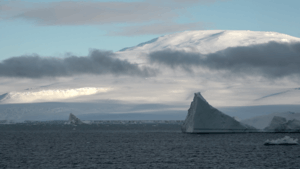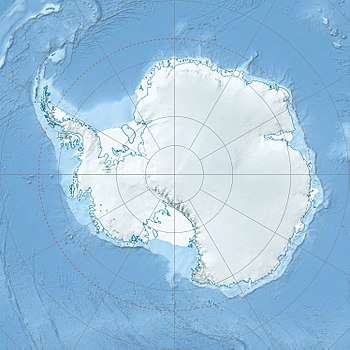Mount Siple
Mount Siple is a potentially active Antarctic shield volcano, rising to 3,110 metres (10,203 ft) and dominating the northwest part of Siple Island, which is separated from the Bakutis Coast, Marie Byrd Land, by the Getz Ice Shelf.[3] Its youthful appearance strongly suggests that it last erupted in the Holocene. It is capped by a 4-by-5-kilometre (2.5 mi × 3.1 mi) summit caldera, and tuff cones lie on the lower flanks.[2] Recely Bluff is on the northeast slope of the mountain, about 7 nautical miles (13 km) from the peak. Its volume of 1,800 cubic kilometres (430 cu mi) is comparable to that of Mount Erebus.
| Mount Siple | |
|---|---|
 | |
| Highest point | |
| Elevation | 3,110 m (10,200 ft) [1] |
| Prominence | 3,110 m (10,200 ft) [1] Ranked 78th |
| Isolation | 363 km (226 mi) |
| Listing | Ultra |
| Coordinates | 73°26′S 126°40′W [2] |
| Geography | |
 Mount Siple Location in Antarctica | |
| Location | Siple Island, Antarctica |
| Geology | |
| Age of rock | Unknown |
| Mountain type | Shield volcano |
| Volcanic field | Marie Byrd Land Volcanic Province |
| Last eruption | Unknown[2] |
| Climbing | |
| First ascent | Unclimbed [1] |
Mount Siple is named after Paul A. Siple (1908–68), a US Antarctic explorer and geographer who took part in six Antarctic expeditions, including the two Byrd expeditions of 1928-30 and 1933-35 (Siple Coast, Siple Island). He was in command of the West Base of the US Antarctic Service (USAS), 1939–41, and was navigator on all major exploratory flights from the base, including the flight on which Mount Siple was discovered.[3]
The mountain has no known record of being climbed. If it is in fact unclimbed, it is one of the most prominent unclimbed mountains in the world (see highest unclimbed mountain). It receives very little publicity due to its remote location, and its topography has only been recorded by a sketch map. It has received fewer visits than many of its neighboring volcanoes.

The volcano was visited in February 2017 as part of the Swiss Polar Institute's Antarctic Circumnavigation Expedition. Al Jazeera English Science and Technology editor Tarek Bazley was on board and filed a news report on his visit to a colony of Adele penguins breeding there.[4][5]
See also
References
- "Antarctica Ultra-Prominences" Peaklist.org. Retrieved 2011-11-21.
- "Siple". Global Volcanism Program. Smithsonian Institution.
- U.S. Geological Survey Geographic Names Information System: Mount Siple
- "Penguins on the move in a warming world". www.aljazeera.com. Retrieved 2017-04-21.
- Al Jazeera English (2017-02-25), Antarctica penguins move south in search of cold, retrieved 2017-04-21
- LeMasurier, W. E.; Thomson, J. W., eds. (1990). Volcanoes of the Antarctic Plate and Southern Oceans. Antarctic Research Series. 48. American Geophysical Union. p. 512. ISBN 0-87590-172-7.
External links
- Mount Siple at skimountaineer.com
- "Mount Siple, Antarctica" on Peakbagger